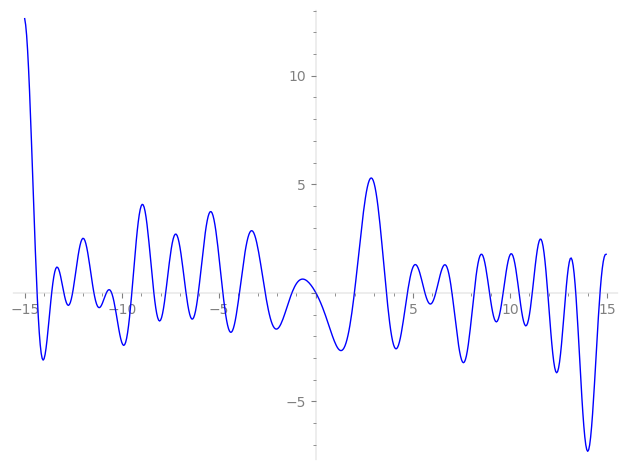| L(s) = 1 | + (−0.5 − 0.866i)2-s + (−1.5 − 0.866i)3-s + (−0.499 + 0.866i)4-s + 1.73i·6-s + (−0.866 − 2.5i)7-s + 0.999·8-s + (1.5 + 2.59i)9-s + (−2.59 − 1.5i)11-s + (1.49 − 0.866i)12-s + 3.46·13-s + (−1.73 + 2i)14-s + (−0.5 − 0.866i)16-s + (−3 − 1.73i)17-s + (1.5 − 2.59i)18-s + (−3 + 1.73i)19-s + ⋯ |
| L(s) = 1 | + (−0.353 − 0.612i)2-s + (−0.866 − 0.499i)3-s + (−0.249 + 0.433i)4-s + 0.707i·6-s + (−0.327 − 0.944i)7-s + 0.353·8-s + (0.5 + 0.866i)9-s + (−0.783 − 0.452i)11-s + (0.433 − 0.250i)12-s + 0.960·13-s + (−0.462 + 0.534i)14-s + (−0.125 − 0.216i)16-s + (−0.727 − 0.420i)17-s + (0.353 − 0.612i)18-s + (−0.688 + 0.397i)19-s + ⋯ |
\[\begin{aligned}\Lambda(s)=\mathstrut & 1050 ^{s/2} \, \Gamma_{\C}(s) \, L(s)\cr =\mathstrut & (0.00342 - 0.999i)\, \overline{\Lambda}(2-s) \end{aligned}\]
\[\begin{aligned}\Lambda(s)=\mathstrut & 1050 ^{s/2} \, \Gamma_{\C}(s+1/2) \, L(s)\cr =\mathstrut & (0.00342 - 0.999i)\, \overline{\Lambda}(1-s) \end{aligned}\]
Particular Values
| \(L(1)\) |
\(=\) |
\(0\) |
| \(L(\frac12)\) |
\(=\) |
\(0\) |
| \(L(\frac{3}{2})\) |
|
not available |
| \(L(1)\) |
|
not available |
\(L(s) = \displaystyle \prod_{p} F_p(p^{-s})^{-1} \)
| $p$ | $F_p(T)$ |
|---|
| bad | 2 | \( 1 + (0.5 + 0.866i)T \) |
| 3 | \( 1 + (1.5 + 0.866i)T \) |
| 5 | \( 1 \) |
| 7 | \( 1 + (0.866 + 2.5i)T \) |
| good | 11 | \( 1 + (2.59 + 1.5i)T + (5.5 + 9.52i)T^{2} \) |
| 13 | \( 1 - 3.46T + 13T^{2} \) |
| 17 | \( 1 + (3 + 1.73i)T + (8.5 + 14.7i)T^{2} \) |
| 19 | \( 1 + (3 - 1.73i)T + (9.5 - 16.4i)T^{2} \) |
| 23 | \( 1 + (3 + 5.19i)T + (-11.5 + 19.9i)T^{2} \) |
| 29 | \( 1 - 3iT - 29T^{2} \) |
| 31 | \( 1 + (1.5 + 0.866i)T + (15.5 + 26.8i)T^{2} \) |
| 37 | \( 1 + (1.73 - i)T + (18.5 - 32.0i)T^{2} \) |
| 41 | \( 1 - 6.92T + 41T^{2} \) |
| 43 | \( 1 - 8iT - 43T^{2} \) |
| 47 | \( 1 + (6 - 3.46i)T + (23.5 - 40.7i)T^{2} \) |
| 53 | \( 1 + (4.5 - 7.79i)T + (-26.5 - 45.8i)T^{2} \) |
| 59 | \( 1 + (-0.866 + 1.5i)T + (-29.5 - 51.0i)T^{2} \) |
| 61 | \( 1 + (30.5 - 52.8i)T^{2} \) |
| 67 | \( 1 + (1.73 + i)T + (33.5 + 58.0i)T^{2} \) |
| 71 | \( 1 - 12iT - 71T^{2} \) |
| 73 | \( 1 + (-3.46 + 6i)T + (-36.5 - 63.2i)T^{2} \) |
| 79 | \( 1 + (0.5 + 0.866i)T + (-39.5 + 68.4i)T^{2} \) |
| 83 | \( 1 - 8.66iT - 83T^{2} \) |
| 89 | \( 1 + (-5.19 - 9i)T + (-44.5 + 77.0i)T^{2} \) |
| 97 | \( 1 + 5.19T + 97T^{2} \) |
| show more | |
| show less | |
\(L(s) = \displaystyle\prod_p \ \prod_{j=1}^{2} (1 - \alpha_{j,p}\, p^{-s})^{-1}\)
Imaginary part of the first few zeros on the critical line
−9.482541967836300988794467564422, −8.346596293764472682750887984166, −7.73797270931369872945207767938, −6.68975243829269091273780813837, −6.05699670719865008516638579394, −4.79196407689664757775744195782, −3.93863113598051416985130476312, −2.60977514441919106655771403569, −1.23624692067507408870995222339, 0,
1.98251300528504065055767943605, 3.63324165221143756356840086905, 4.71383007952415188173498076501, 5.61605459286275017501719482348, 6.17405697917139266517252019248, 7.00875333003205074510190238527, 8.147594357469723068483311779922, 8.943172666408460464691398410332, 9.644284475153166885071287479442

